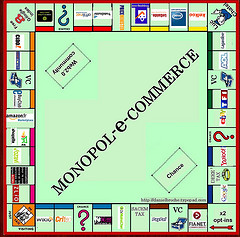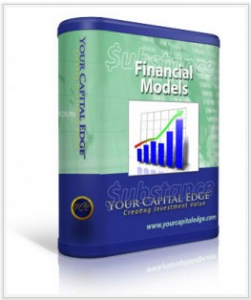Financial Modeling Tips
Crowdfunding Whitepaper. Measuring Return on Involvement
 Crowdfunding for entrepreneurs and investors is a hot topic — and it’s only going to get more attention in the near term, as the American JOBS Act makes Equity Crowdfunding a reality for those looking to raise business capital with this innovative model. Creekstone Consulting Inc. wanted to dig deeper into this phenomenon and has developed an industry white paper to help explain how business owners and investors alike plan to use Equity Crowdfunding to revolutionize business models.
Crowdfunding for entrepreneurs and investors is a hot topic — and it’s only going to get more attention in the near term, as the American JOBS Act makes Equity Crowdfunding a reality for those looking to raise business capital with this innovative model. Creekstone Consulting Inc. wanted to dig deeper into this phenomenon and has developed an industry white paper to help explain how business owners and investors alike plan to use Equity Crowdfunding to revolutionize business models.
- Read our white paper on Equity Crowdfunding. Measuring the New ROI: Return on Involvement
Some of our key discoveries from talking with business experts and representatives from crowdfunding platforms gave us insight into how creative people are thinking about using this model to their advantage — and why it’s so important for countries like Canada to join the USA and Europe and get on the Equity Crowdfunding bandwagon:
- Equity Crowdfunding lets companies relatively easily create strong engagement with their consumer base which can become self- sustaining. Investors can be consumers as well as “evangelists” helping the company promote itself.
- Investors may seek out this kind of engagement willingly, seeing value in being able to “be part of something they believe in”.
- The equity Crowdfunding model can be very effective both for start-ups in the “idea” stage as well as mature companies that already have revenue. All participants gave particular attention to questions surrounding the motivations of both companies and investors to get involved in equity Crowdfunding.
Here’s an excerpt from our white paper:
Lopez concurs that many of EarlyShares’ signed-up companies are intending to use equity crowdfunding for publicity. “I can think of one company in New York City with 150 employees and millions in revenue and multiple locations… they’re doing a $500,000 raise for marketing purposes. They’re giving up 5 percent equity to have 5,000 customers. They will be able to say they’re partly customer-owned, and you’ve automatically proved customer loyalty.”
That marketing bonus is sustainable: “If they own a piece of your company, they will naturally want to buy from you. You get money, customers with a vested interest and market validation for your product before you even launch it. You can’t get that from a survey or a focus group!”
Good Dilution or Bad Dilution. Know When Greed is Good
In the 1987 film “Wall Street”, Michael Douglas in playing the lead role of Gordon Gekko proclaimed “Greed, for lack of a better word, is good. Greed is right. Greed works. Greed clarifies, cuts through, and captures, the essence of the evolutionary spirit….”
Well what does greed have to do with share dilution and the entrepreneur?
Simply, in order to get capital an entrepreneur has to give up a portion of his or her company. Many entrepreneurs do not have deep pockets to delve into to feed their cash starved ventures – so they must ask investors for cash. For some entrepreneurs this becomes a tremendously agonizing and emotional decision since the thought of giving up a percentage of the company and thus potentially control of the company is untenable. The problem – the entrepreneur’s unbridled ego and an unabated view of fear and, yes, greed of giving up something of higher value than the utility that cash can bring. This can blur vision of getting the capital needed to get a company to the next stage of important development.
However, let’s take a step back. In the beginning a start-up company entrepreneur owns a 100% of the company. Sounds impressive, but a 100% of a high risk venture, with no revenues just expenses and a great deal of hope is really 100% of nothing. When cash is needed an entrepreneur has to raise money and it’s the issuance of shares that triggers ownership dilution. This is good dilution because when investors see value they expect a favorable return which means the company must have some accretive promised value. So all things being equal, if an investor acquires 40% of the company for $500,000 and this $500,000 can create even more enterprise value, then the entrepreneurs 60% is worth more than the 100% initial ownership. Good dilution means a share unit has increased in price and when multiplied by the number of shares held by the entrepreneur it means an overall appreciated value of his holdings. (more…)
Value Is Different from Price
The North American consumer is addicted to low prices when it comes to plenty of kinds of consumer goods, but companies are wise to heed Guy Kawasaki’s strategic advice: price isn’t everything – and value is different from price.
Writing recently on what he had learned from Steve Jobs, Kawasaki wrote that “Price is not all that matters-what is important, at least to some people, is value. And value takes into account training, support and the intrinsic joy of using the best tool that’s made. It’s pretty safe to say that no one buys Apple products because of their low price.
Apple is far from the only company that has profited by providing value for its customers rather than a single-minded focus on the price tag.
Nobody buys Prius cars because they’re cheap – even with government subsidies, these eco-friendly cars that are tapping into a style-conscious and green-minded consumer are not inexpensive. And think about how much people are willing to pay for Hallmark cards, simple paper products, that can go for $5 or $6 each. Cost-conscious buyers could pick up a whole box of cards at a dollar store for the same price, or even send a message for free with an eCard, but Hallmark’s well-written passages keep drawing people back for more.
What is the value that you are providing for your target consumer? The question will keep popping up when:
- putting together your business plan
- hiring employees – how will your people help create the value you want to offer? Specialized skills that your competitors don’t have? Customer service?
- understanding your company’s strengths and weaknesses. How does the value you help cover over the gaps?
- presenting to investors. Does your PDF presentation talk about the value you’re offering? What pain point are you helping your customers with?
You can’t entirely neglect price. It’s an important part of your overall business plan. But as Kawasaki would point out, taking part in a race to the bottom in terms of pricing hasn’t helped virtually every Apple competitor overcome the giant’s value proposition. While they’re struggling to achieve profit margins of 5 to 8 percent, Apple’s profit margin is closer to 30 percent – and that’s the value of focusing on value.
Crowdsourcing Funding for Startups
A self-publisher of a web-comic asked for $57,000 on Kickstarter to reprint a series of comic strips and raised ten times as much from more than 7,000 backers – with two weeks to go before the funding drive ended. Meanwhile, a new fashion company took in over $64,000 from nearly 800 funders to launch their new line of multi-functional fabrics – tripling the amount they initially asked for. Clearly, the age of crowdsourced funding has arrived; it’s time Canadian entrepreneurs started examining the possibilities. Actually, they are.
Crowdfunding for new companies and established ventures
Crowdfunding, otherwise known as crowdsourcing, as an alternative source for funding companies is getting more attention these days, since the US Senate has got on board in November with the “Entrepreneur Access to Capital Act”.
According to Forbes Magazine, the legislation allows companies to bypass dated regulations to take advantage of the flourishing online fundraising economy. Specifically:
The bill provides a crowd funding exemption from Securities and Exchange Commission registration of securities offerings, with certain limitations: (more…)
eCommerce for Business Hits Stride
The e-commerce based revenue model helped businesses score record profits over the holiday season. Clearly, this is one revenue stream that entrepreneurs can’t afford to ignore. That said, startup executives need to think clearly about how this revenue model will work in conjunction with the rest of their business plan in order to entice investors.
- (Download our E-Commerce Based Revenue Financial Model. Automatically generate balance sheets and cash flow statements.)
The e-Commerce Revenue Model Opportunity
The numbers for eCommerce shopping over the holidays were staggering even before Boxing Day, according to Network World:
During the one-week period ended Dec. 18, online retail shoppers spent a record $6.3 billion. On four days of that week, the single-day e-commerce tally surpassed $1 billion dollars, according to web watcher comScore.
So far this season, consumers have spent nearly $32 billion online, which is a 15 percent increase compared to the corresponding days of last year’s November-December holiday season. The volume of sales is expected to slow as the holidays draw near and shoppers head for the malls.
For established brick-and-mortar companies, the e-Store has become an essential revenue source; for companies like Amazon and Apple (iTunes store), the online shopping cart is the most important way they make money. And during the holidays, there is an added benefit; since most entrepreneurs actually enjoy taking time off to spend with their families, letting e-Stores handle customers has obvious advantages. The revenue keeps rolling in even as you’re unwrapping gifts in your living room. (more…)
Anatomy of a Capitalization Table
 An important part of launching a company is deciding who owns what. When you have multiple owners or when giving out shares to employees, you need to know how the share structure of the company plays out each time you accept money from investors.
An important part of launching a company is deciding who owns what. When you have multiple owners or when giving out shares to employees, you need to know how the share structure of the company plays out each time you accept money from investors.
- (Click to download the YCE Capitalization Table product it’s FREE to download!)
As I indicated in my previous blog on the importance of capitalization tables, they describe a company’s investment a story both past and future. For some entrepreneurs new to the process of raising capital a capitalization table can be a valuable tool in understanding the impact of an investment on such issues as ownership percentages, share valuation, dilution, and exit preferences. Learning how various deal making alternatives can result in varying outcomes will provide the entrepreneur with a better basis for negotiating with investors.
A useful cap table should allow for easy identification of each individual shareholder’s number of stock held at each step, their percentage owned at each step, the share price for each round, and the pre- and post-money valuations of each round.
Summary on the component parts of a capitalization table
Netflix and the Success of the Subscription-Based Revenue
 What do software, magazines, certain types of television shows, phone service and fitness centers all have in common? All of these businesses operate according to a subscription-based revenue financial model.
What do software, magazines, certain types of television shows, phone service and fitness centers all have in common? All of these businesses operate according to a subscription-based revenue financial model.
As Netflix has demonstrated, this model that has been around for ages, when coupled with technological innovation, can provide an edge to knock established industry giants off their feet.
The story of Netflix vs. Blockbuster is already being used in business schools as a case study in competitive business models. Blockbuster, as we know, has already filed for bankruptcy. Netflix, despite some serious and well-publicized setbacks in 2011 due to conflict with content providers, is still very much alive and kicking (and ultimately, those content providers will likely have to come around).
The Gourmet Retailer provides a synopsis of the trend in Has Business Really Changed?:
The neighborhood video rental store is on its last legs because guess what, streaming video from Netflix and others is rampaging into America’s living room. Netflix vs. Blockbuster was no contest. Blockbuster opened 4,000 stores in two decades. Netflix sales were up 43,101 percent from 1999. That’s not a mistake, sales were up 43,101 percent and Blockbuster filed for bankruptcy in 2010. And music stores keep closing. iTunes made its debut in 2003 with devastating effects on music retailers. Tower Records went out of business in 2004, and Musicland folded in 2006. Songs sold on iTunes: up 1,169,900 percent from 2003. The trend is clear.
It’s not that brick-and-mortar stores are on the way out. Clearly, some types of retailers are here to stay for the foreseeable future. People still like to shop for their own groceries in supermarkets. Plenty of customers still like to try on clothes at the Gap. Electronics retailers like Best Buy often have sophisticated e-shopping websites with discounts on their in-store products, but they still have enough walk-in traffic to justify giant big-box stores.
That said, a subscription model can offer competitive advantage in a number of ways. Importantly, revenue is more consistent. Yes, people do change or cancel their subscriptions, but those decisions are not made as often as purchasing decisions. Companies can continue to earn revenue for months or even years before a customer finally gets around to canceling. Most of us who got fitness club memberships and stopped showing at the gym can relate to this situation from the other side of the ledger.
Financial Models with Sensitivity Analysis: Subscription Revenue
Perhaps you’re already considering developing a subscription revenue model business. Success for these types of companies in particular depends on accurate financial projections. Our downloadable templates include revenue forecasting sheets, cost assumption sheets that then automatically generate financial statements such as Income, Balance Sheets and Cash Flow statements. These will help you understand how your business “pencils out”..
DOWNLOAD Financial Models with Sensitivity Analysis: Subscription Revenue
Your Capital Edge Resource Bundle. A Sound 100 Dollar Investment
 Your Capital Edge is the successful entrepreneur’s secret toolkit that helps you raise capital, create investor presentations, formulate an HR plan, secure financing, locate Angel Investors, make accurate cash-flow projections and more.
Your Capital Edge is the successful entrepreneur’s secret toolkit that helps you raise capital, create investor presentations, formulate an HR plan, secure financing, locate Angel Investors, make accurate cash-flow projections and more.
- Purchase the YCE Resource Bundle today for just $50 (saving $50 off the regular price)
We’ve had a great response from colleagues and clients who understand the value of our tools and templates that help you save time and money. And now we’re offering an even better deal for those who want a lot of tools all at once – and for a low price.
Tools for Startup Entrepreneurs and Leaders of Established Companies
With the YCE Resource Bundle you can download a complimentary suite of tools at a 50 percent discount (or a savings of $100). The bundle includes the following downloads:
- How to Create a Business Plan
- Investor Presentations Templates and Overview on Preparation
- Legal Disclosure Templates
- Lexicon
- Investment Summary Templates
- Investor Communication Checklist
- SWOT Analysis
- Capitalization Table
- Human Resource Model
- Due Diligence Checklist
- Industry and Competitor Research
- NDA Samples
- Valuation Model
- Market Research Tool Box
For those entrepreneurs and managers who want a comprehensive toolbox, this is a great value. For $100, you get a bundle of resources that can help you on your way to developing your own successful venture. This could just be the best investment you make all year.
Company Valuation Model Mistakes
 How do you value a startup company that isn’t publicly traded and has no revenues?
How do you value a startup company that isn’t publicly traded and has no revenues?
Valuation can be a black art even when you’ve got revenues and a record of expenditure you can use to calculate projected profits over a number of years. After all, who is to say that those profits will stay constant? What if a competitor comes out with a product that’s going to give your company a run for its money?
How to Value a Company. Use the Tools and Avoid Common Mistakes
Valuation can be very subjective. And again, if you’re dealing with a startup, there are so many variables it can be tough for an entrepreneur or investor to know where to begin.
Here are some common mistakes even self-styled experts have made that you want to avoid:
- Lack of objectivity. A company executive may be tempted to post an overly optimistic business forecast. Skittish investors who don’t have all of the information may be too pessimistic. You need balance.
- Forget about cash flow. It is tempting to look at the overall revenue minus expenditures and call it a day. But what happens when a company faces monthly bills and only manages to get paid by its customers every 3 to 6 months? Once the startup cash burns out, a problem with cash flow can put the kibosh on a business – which won’t do wonders for its valuation.
- Counting intangibles. Customer goodwill, great branding and a convenient location are already accounted for in the company’s sales (eg. When Apple sells an iPad, its sale is a result of its brand recognition and easy-to-find stores). So you don’t need to count these things twice.
- Comparing apples and oranges. “Industry average” revenues or expenditures may not apply to a single niche company touting an innovative business model or blockbuster product.
Try our easy-to-use valuation tool to develop guidelines for discussion with investors
Capital Edge Roundup. Forecasting, Financial Modeling, Investment Value Propositions and more
When I developed Your Capital Edge’s modules teaching the Strategy, Structure, Substance, and Sizzle of investing, my aim was to educate entrepreneurs in how to raise equity capital.
Helping entrepreneurs better understand how these enterprise value enhancing principles work is an ongoing process. Here is a roundup of some of my recent and most popular companion articles about entrepreneurship and investing.
- Forecasting and Financial Modeling. Financial models help us understand what could be in store for the company and assist in decision-making.
- An Investment Value Proposition. What investors want to hear (and what they don’t want to hear).
- Columbus and Today’s Entrepreneur— A Common Bond? Was the discovery of the New World an incredibly successful partnership between an entrepreneur and a venture capitalist?
- Bricks and Mortar – Moving from the Garage to Real Office Space. what can an entrepreneur do to ease the burden of these essential tasks and move on with the larger goal of building an entrepreneurial enterprise?
Naturally, I’m an avid reader of the most interesting investment blogs and business news articles that tie into the work I do. Here is a roundup of what I’ve been reading.
- Should Startups Move To Be Close To Venture Capital? Probably not, it turns out.
- Raising Venture Capital – Horror Stories and Other Bad Behavior. Not for the faint-hearted.
- This 7-Year-Old Entrepreneur Wants To Be The World’s Youngest Investor. Apparently, you’re never too young to start.

Browse Our Blog
- Angel Investors
- Articles
- Business Strategy Tips
- Company Valuation
- Crowdfunding
- Due Diligence
- Entrepreneur tips
- Financial Forecasting
- Financial Modeling Tips
- Going Public IPO
- Government grant business
- High Tech Startup News
- Invest in a business
- Market Research Tips
- Raising Investment Capital
- Raising Venture Capital
- Startup entrepreneur tips
- Vancouver business news
- Video

News & Links









